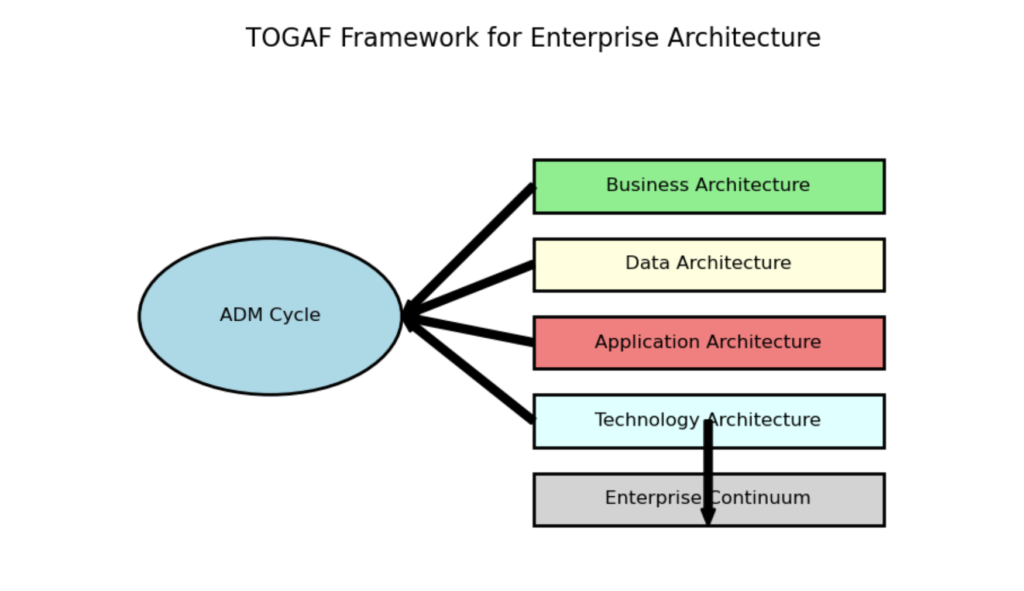-
TOGAF (The Open Group Architecture Framework) organizes enterprise architecture into four interrelated domains. These domains provide a structured way to analyze, design, and implement systems that align with business goals.
🔍 The Four Architecture Domains (Explained in Detail)
1. Business Architecture
This domain defines:
- The organizational structure
- Business processes
- Capabilities, functions, and roles
- Strategic goals and objectives
It answers:
👉 What does the business do? Who does it? Why does it matter?2. Data Architecture
This domain focuses on:
- Data models (conceptual, logical, physical)
- Data flows and data governance
- Data storage, integration, and security
It answers:
👉 What data is needed? Where is it stored? How is it accessed and secured?3. Application Architecture
This domain defines:
- The software applications used in the enterprise
- Interactions between applications
- Interfaces and integration patterns
It answers:
👉 What applications support the business? How do they interact?4. Technology Architecture
This domain includes:
- Infrastructure (servers, networks, cloud platforms)
- Middleware, operating systems, and technical standards
- Security, performance, and scalability
It answers:
👉 What technology supports the applications and data?
🧠 Real-World Example: Smart City Transportation System
Let’s say a city government is building a Smart Transportation System to reduce traffic congestion and improve commuter experience.
🔹 Business Architecture
- Goal: Reduce average commute time by 20% in 2 years.
- Stakeholders: City planners, commuters, traffic police, public transport authorities.
- Processes: Route planning, traffic monitoring, public transport scheduling.
🔹 Data Architecture
- Data Sources: GPS data from buses, traffic sensors, commuter feedback, weather data.
- Data Models: Real-time traffic flow, historical congestion patterns.
- Governance: Data privacy policies, open data standards for public access.
🔹 Application Architecture
- Apps: Mobile app for commuters, dashboard for traffic control center, APIs for third-party developers.
- Integration: Real-time data feeds from IoT sensors, integration with Google Maps and public transport APIs.
🔹 Technology Architecture
- Infrastructure: Cloud-based platform (e.g., AWS or Azure), 5G connectivity, edge computing for real-time processing.
- Security: End-to-end encryption, role-based access control.
- Scalability: Designed to support millions of data points per day.
🖼 Visual Diagram
Here’s a visual representation of how these domains stack and interact:

📝 Summary
The four architecture domains in TOGAF—Business, Data, Application, and Technology—offer a comprehensive framework for aligning IT with business strategy. Whether you’re building a smart city, modernizing a bank, or transforming healthcare, these domains help ensure that every layer of your enterprise is working in harmony.
-
A Framework for Enterprise Architecture
- Posted on: June 2, 2025
- by: Anand Pandey
- 0 Comments
In a world where technology and business are deeply intertwined, organizations need a structured approach to align their IT capabilities with strategic goals. That’s where TOGAF (The Open Group Architecture Framework) comes in—a comprehensive framework for designing, planning, implementing, and governing enterprise architecture.
🧱 What is TOGAF?
TOGAF is a globally recognized framework that provides a methodology and set of tools for developing enterprise architecture. It helps organizations manage complexity, improve decision-making, and ensure that IT investments support business outcomes.
At its core, TOGAF is built around the Architecture Development Method (ADM)—a step-by-step approach to developing and managing enterprise architecture.
🧩 Key Components of the TOGAF Framework
1. Architecture Development Method (ADM)
The ADM is the heart of TOGAF. It provides a structured cycle for developing architecture, from vision to implementation and governance.
2. Architecture Domains
TOGAF divides enterprise architecture into four domains:
- Business Architecture – Defines business strategy, governance, and processes.
- Data Architecture – Structures data assets and data management.
- Application Architecture – Describes individual applications and their interactions.
- Technology Architecture – Details the infrastructure and technology stack.
3. Enterprise Continuum
This is a classification model that helps organize and reuse architectural assets across the enterprise—from generic foundation architectures to specific organizational solutions.
🖼 Visualizing the TOGAF Framework
Here’s a visual diagram that illustrates how the ADM cycle connects with the architecture domains and the Enterprise Continuum:

✅ Real-World Example
Imagine a national education board planning a digital transformation:
- The ADM cycle guides the process from defining the vision to deploying new systems.
- The Business Architecture defines goals like improving student access and digital learning.
- The Data Architecture structures student records, performance metrics, and learning content.
- The Application Architecture includes learning management systems and mobile apps.
- The Technology Architecture covers cloud infrastructure, security, and device management.
- The Enterprise Continuum helps reuse proven models and adapt them to the education sector.
📝 Summary
The TOGAF framework offers a powerful, structured approach to enterprise architecture. By combining the ADM cycle, architecture domains, and the Enterprise Continuum, TOGAF helps organizations align technology with strategy, reduce complexity, and drive innovation. Whether you’re modernizing legacy systems or launching new digital initiatives, TOGAF provides the blueprint for success.
Tag